News & Views
Have Scientists Discovered a Bisexual Bird Commune?
May 20 2016
Of all the Kingdom Animalia, birds are widely recognised for their sophisticated social behaviour. Think flocks migrating in unison, penguins raising their young in rookeries and ravens collaborating to bring down prey. Now, scientists have uncovered exciting new insight into the lives of a certain species of bird, and bisexuality is the name of the game.
In Panamanian forests, researchers have successfully observed the social interactions of sapayoa birds (Sapayoa aenigma) for the very first time. They monitored activity in two active nests, and found that cooperative breeding is a present and established behaviour. In other words, bisexual family communes keep the sapayoa population alive and flapping.
Multifaceted roles
One ‘family’ was made up of six birds, with researchers observing two immature males assisting the dominant male and female in the care of the nest’s two chicks. At another point the adult male engaged in sexual behaviour with a juvenile male, a behaviour that the two younger male birds also displayed. In another unexpected observation, the younger males often landed at the nest with food, yet neglected to share it with the younger birds. Sarah Dzielski, lead author of the study explains that this unusual conduct could be social dominance playing out.
“This could represent ‘fake-feeding,’ when birds bring food to the nest to appear like team players, but sneakily eat it themselves. It’s also possible that the young males were simply balancing the needs of the chicks with their own hunger. Clearly, there is much still to learn.”
A worldwide phenomenon?
As a unique species, the sapayoa’s closest relatives are a 50 strong group of ‘Old World suboscines’ that live in Africa and Asia. This group is also known for its cooperative breeding behaviour, and the discovery of a South American division is an exciting find for the naturalist community.
“The Sapayoa is so different from other passerine birds that it is currently placed in its own family, Sapayoidae, but relatively little is known about its natural history,” explains co-author of the study, Benjamin Van Doren. “This gap in scientific knowledge was the reason we travelled to eastern Panama to learn about this enigmatic species. We hoped that more information about the Sapayoa’s natural history would cast its surprising evolutionary relationships in a new and clearer light.”
The reproductive behaviour of animals is endlessly fascinating to zoologists. ‘A Practical Field Extraction Method for Non-invasive Monitoring of Hormone Activity in Animals’ delves deeper into non-invasive hormone analysis, and the benefits it offers for studying the adrenal and reproductive status of a species.
Digital Edition
Lab Asia 31.2 April 2024
April 2024
In This Edition Chromatography Articles - Approaches to troubleshooting an SPE method for the analysis of oligonucleotides (pt i) - High-precision liquid flow processes demand full fluidic c...
View all digital editions
Events
Apr 22 2024 Marrakech, Morroco
Making Pharmaceuticals Exhibition & Conference
Apr 23 2024 Coventry, UK
Apr 23 2024 Kintex, South Korea
Apr 23 2024 Seoul, South Korea
Apr 24 2024 Jakarta, Indonesia




.jpg)













